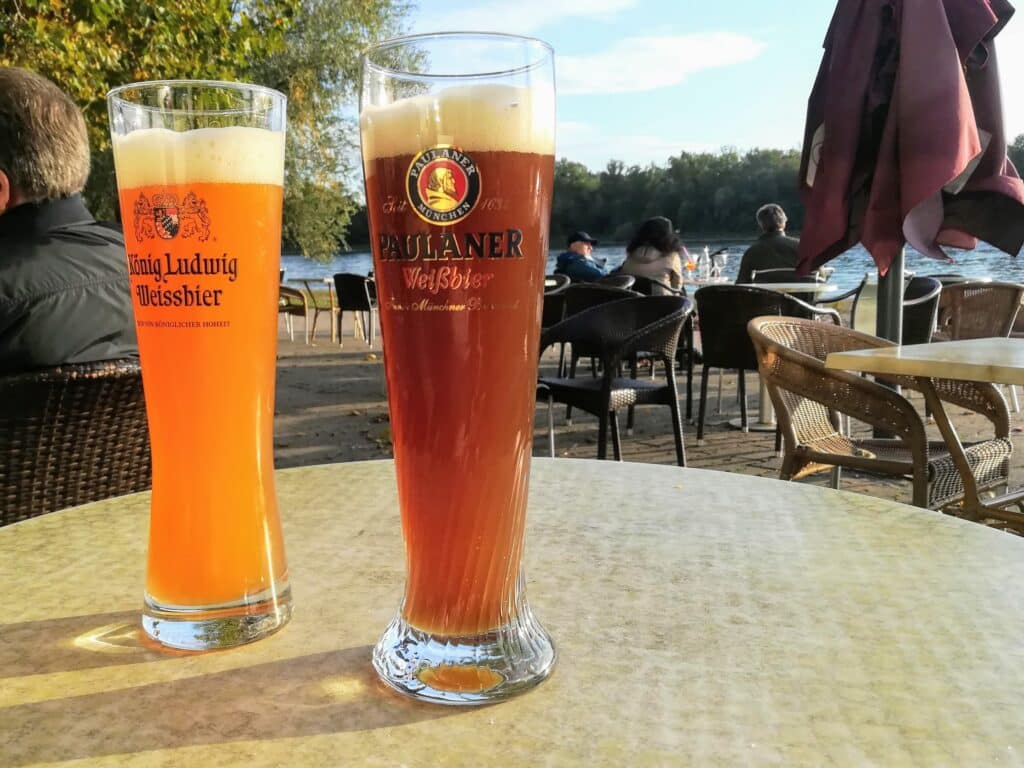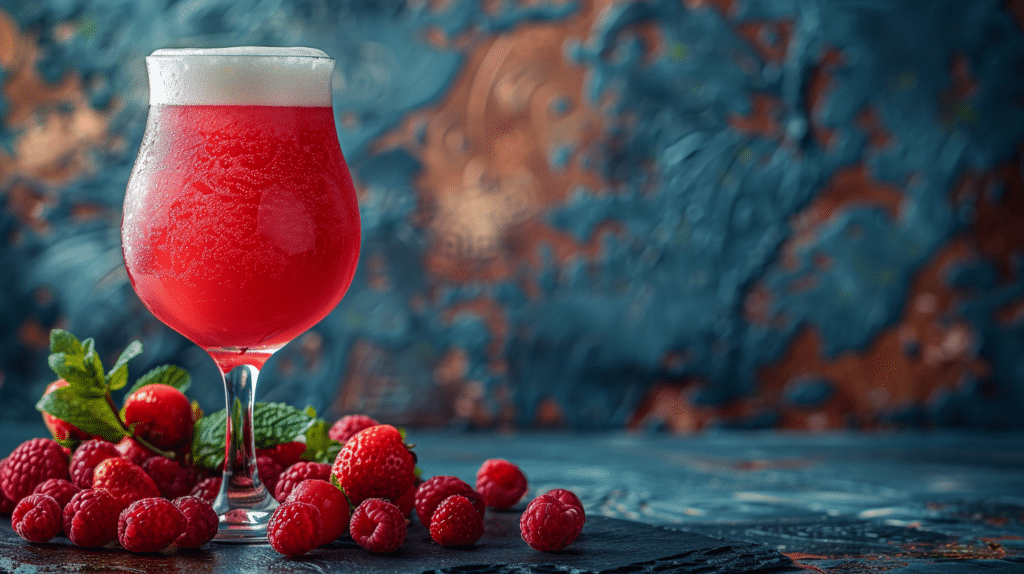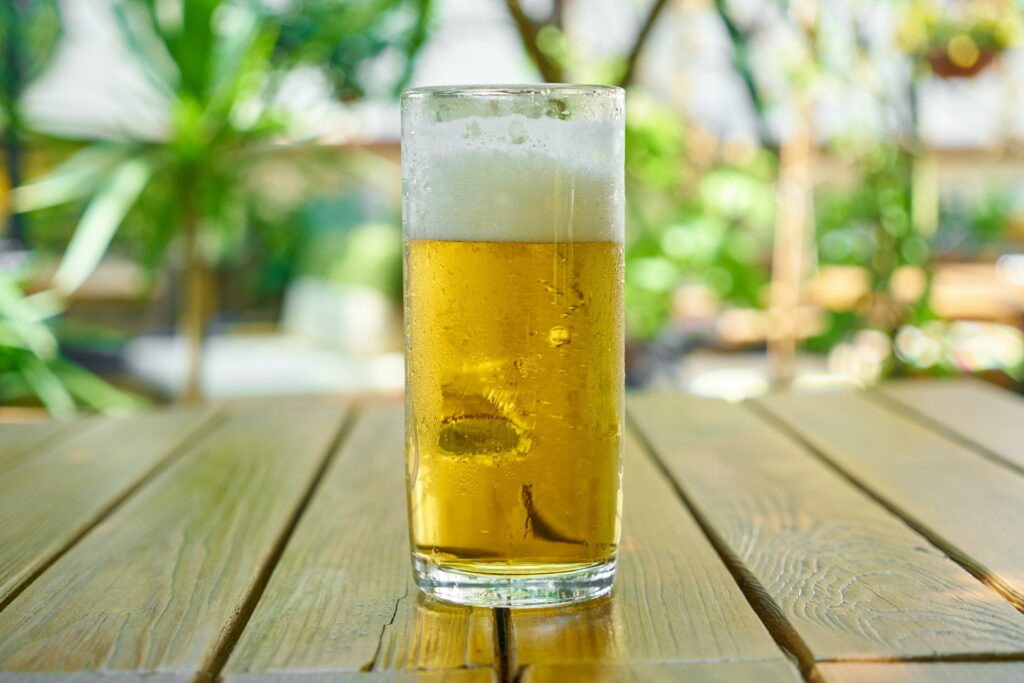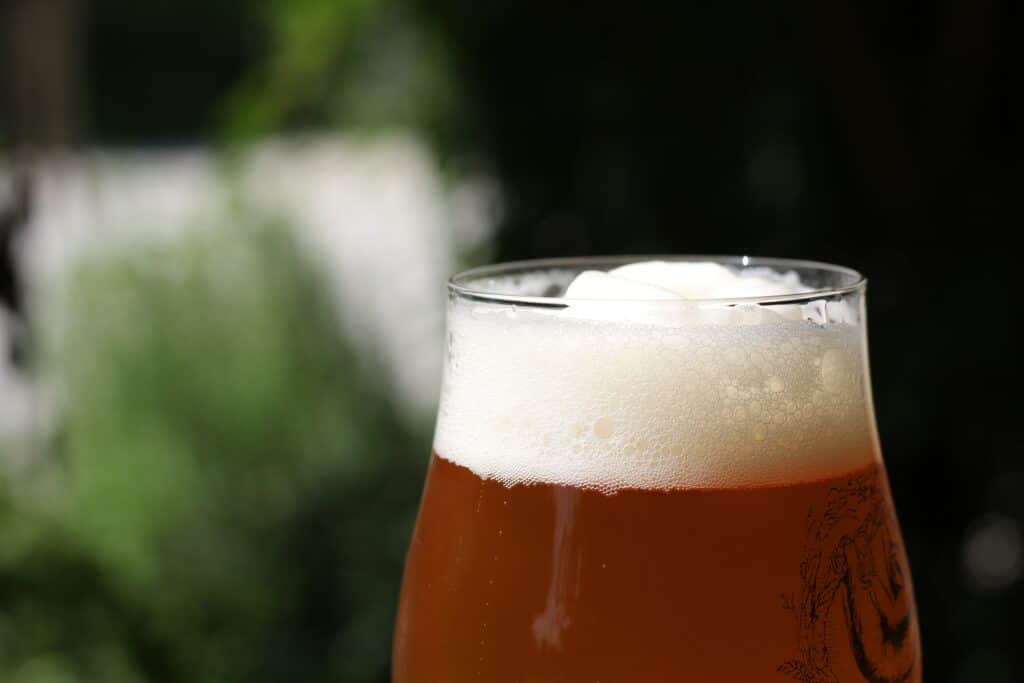Disclaimer: This post may contain affiliate links, from which I may earn a small commission at no extra cost to you. Thank you for supporting Ale Affair.
Lager vs Wheat Beer. The showdown that nobody thought they needed. The showdown that nobody asked for. But I promise you’re in for an instant classic. It is always a tough choice to stand at the bar and decide whether to have your no-frills-attached lager or a classy Belgian Witbier, which comes with its own little slice of orange. Other than coming with a nice snack, what actually sets your wheat beer apart from the lager? Well, without further ado, let’s find out!
A Tale of Two Beers: Lager vs Wheat Beer
In a nutshell, lager is brewed with barley and bottom-fermenting yeast, offering a crisp and clean taste. Wheat beer, with a mix of wheat and barley, uses top-fermenting yeast, resulting in a cloudy appearance and flavours like banana and clove.
But I know you’re not here for a nutshell. Let’s compare the key features that make up these heavyweights of the beer world.
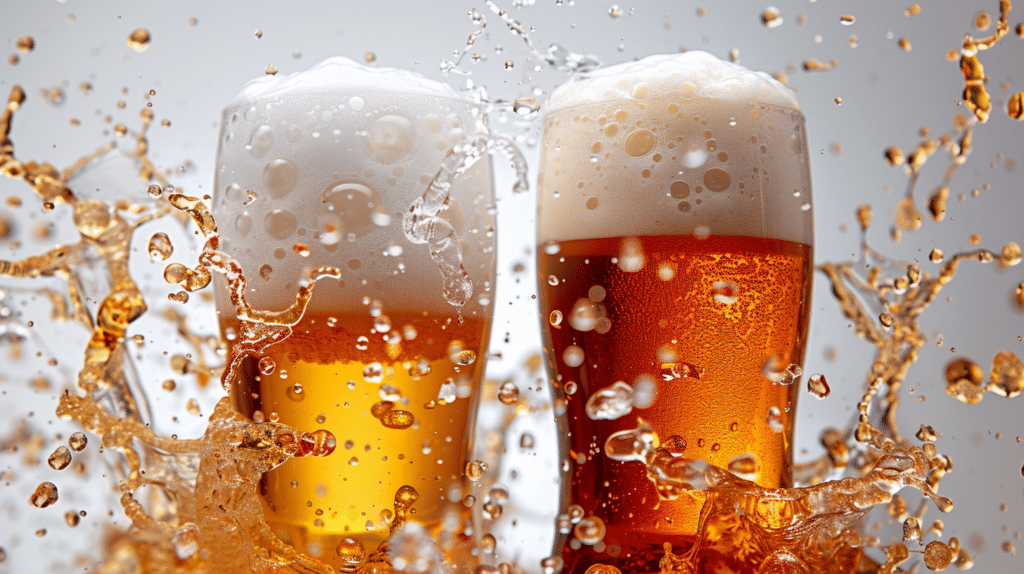
History and Origins
Lager
Lager beer originates from Central Europe, with its development closely tied to the Bavarian region of Germany. The term “lager” comes from the German word “lagern,” which means “to store.” This refers to the cold storage and ageing method used to brew these beers.
Lager brewing techniques were developed in the 15th and 16th centuries, but the practice of lagering beer became more widespread in the 19th century with the advent of refrigeration technology.
The first widely recognised lager, known as the Pilsner, was brewed in the town of Pilsen, now in the Czech Republic, in 1842. This pale, golden beer quickly became popular, leading to the spread of lager brewing across Europe and eventually around the world.
Wheat Beer
Wheat beer, also known as “Weissbier,” “Weizenbier,” or “witbier”, depending on the region, has its origins deeply rooted in German and Belgian brewing traditions. The history of wheat beer dates back to the Middle Ages, with some of the earliest documented brews originating in Bavaria, Germany, around the 15th century.
In Germany, wheat beer became known for its distinctive use of wheat malt in addition to the traditional barley malt. Fun fact: the Bavarian law of 1516, known as the Reinheitsgebot or “Beer Purity Law,” initially restricted beer ingredients to barley, hops, and water. However, wheat beers were granted an exception due to their popularity and royal privilege, allowing them to continue using wheat.
Belgium also has its own wheat beer tradition, known as “witbier” or “white beer,” often flavoured with coriander and orange peel. Interestingly, Belgian Witbier experienced a decline in the 20th century but was revived in the 1960s by Pierre Celis at the Hoegaarden Brewery, leading to a resurgence in its popularity.
Ingredients
Lager is primarily made from barley malt. Lagers can also include other grains, but barley is the most common base. While other grains, such as corn and rice, can also be used in the brewing process, barley is the most commonly used grain for making lagers.
As the name suggests, wheat beer is made with a significant proportion of wheat in addition to barley. What a bloody surprise! The wheat content can range from 30% to 70% of the grain bill, contributing to its distinctive taste and appearance.
Yeast and Fermentation
Lager uses bottom-fermenting yeast (Saccharomyces pastorianus) that works at colder temperatures, typically between 35°F and 50°F (1.7°C – 10°C). This yeast settles at the bottom of the fermenter. Lagering involves storing the beer at cold temperatures for several weeks to several months to clarify and stabilise the beer.
Wheat Beer often uses a unique strain of top-fermenting yeast (Saccharomyces cerevisiae) that operates at warmer temperatures, usually between 60°F and 75°F (15.5°C – 24°C). This yeast tends to rise to the top of the fermenter. The yeast strains used in wheat beers can contribute significantly to the beer’s flavour and aroma, often imparting fruity and spicy notes.
Flavour Profile
I asked my friend James to define the taste of his lager. He said it is clean, crisp, and a refreshing taste. Some people argue all lagers taste the same. However, lagers can range from sweet to bitter, depending on the hops used. They also typically have a more balanced and less pronounced hop flavour compared to some ales.
Now, actually, I’m not too fond of wheat beer, but I have been told that it often has a distinctive taste and aroma with notes of banana, clove, and sometimes citrus. This is, of course, a result of the yeast and wheat used in brewing. These beers are usually less bitter than many other beer styles.
Varieties
There are many types of lager, including Pilsners, Bocks, and Märzens, each with its own unique characteristics and flavour profiles.
On the other hand, there are several sub-styles of Wheat Beer, such as Hefeweizen (unfiltered wheat beer from Germany), Witbier (Belgian-style wheat beer often brewed with spices and orange peel), and American Wheat Ale (a cleaner and often hoppier version of wheat beer).
Must-Try Wheat Beers and Lagers
To truly appreciate the diversity within these beer categories, here are a few must-try recommendations:
- Wheat Beer: Schneider Weisse Original is a classic German Weizenbier; Allagash White is a Belgian-style Witbier from the USA.
- Lager: Pilsner Urquell, the original Pilsner from the Czech Republic; Weihenstephaner Original, a traditional German Helles.
Are Wheat Beers Healthier?
I personally am not one to care about whether one beer is healthier than another. But I hear this is a general worry. So, lucky for you, I have looked into it.
Whether wheat beers are healthier than lagers depends on various factors, including the specific beer’s ingredients, the brewing process, and personal dietary considerations. Generally, the health aspects of beer are related to its caloric content, carbohydrate levels, and presence of certain nutrients.
Let’s break down the aspects that could influence the health comparison between wheat beers and lagers.
1. Caloric and Carbohydrate Content: Wheat beers often have a slightly higher caloric and carbohydrate content due to the wheat’s contribution, which might affect those counting calories or carbohydrates.
2. Gluten Content: Shock, Horror; wheat beers are typically higher in gluten than barley-based lagers. This can obviously be a concern for individuals with gluten sensitivities or celiac disease. However, gluten-reduced or gluten-free beer options are available in both categories for those affected.
3. Antioxidants and Vitamins: The raw materials and the yeast used in brewing can contribute to the vitamin and antioxidant content of beer. Wheat beers often have a slightly different nutritional profile due to the use of wheat and often a different strain of yeast, possibly offering a diverse mix of B vitamins and antioxidants.
Overall, the differences in healthiness between wheat beers and lagers are relatively minor and depend on specific product formulations and individual health considerations. Enjoying beer in moderation, regardless of the type, is part of a balanced approach to health – this is what I tell myself, anyway.
Is Wheat Beer Better than Lager?
Well, you already know my answer, as I’m not a huge fan of wheat beer (which is ok as a beer lover). But I have completed a little research.

Based on available sales data and market trends, lagers tend to be more popular and widely consumed than wheat beers. Lagers, including well-known brands and various sub-styles, dominate the beer market in volume and sales. Wheat beers, while also popular, especially in certain regions like Germany and Belgium, do not match the global sales and distribution levels of lagers.
In 2023, according to a YouGov poll, Budweiser, a lager, was the second most popular beer brand. Actually, six out of the top ten beer brands were lagers. It’s pretty disappointing that the first wheat beer, Hoegaarden, a Belgian wheat beer, only made it to the 56th position on the list.
Interestingly, lager was less popular among male drinkers than female drinkers in the UK. It was the only beer type more popular with women than men. Lager is usually a popular choice for beer-drinking newbies, too.
Ultimately, it is down to personal preference. Why not try a sample of both and decide for yourself?
Does Wheat Beer have more Alcohol?
Now, we are asking the real questions. This is the leading Lager vs Wheat Beer decider for me – the knockout blow! But actually, the answer could be better. Generally, both wheat beers and lagers can range in ABV from as low as 3% to upwards of 8% or more for certain styles.
Wheat beers often have a moderate alcohol content, typically ranging from around 4% to 7% ABV. On the other hand, many standard lagers have an ABV in the range of 4% to 5%. However, stronger lagers like Doppelbocks can have an ABV of 7% or higher.
Just by scanning the popular brands in both categories, you’ll understand this disparity in ABV across both beer types equally. For instance, take a look at two Witbiers: Samuel Adams Imperial White has an ABV of 10.3%, while Blue Moon Belgian White only has a 5.4% ABV. Similarly, if we consider lagers, Dark Helmet Imperial Schwarzbier, a dark lager, has an ABV of 8%, whereas Amstel Light has a 3.5% ABV.
Ultimately, the alcohol in your beer will vary depending on the brand – so pick wisely!
Summary
Let’s sum up today, class. Wheat beer, originating in German and Belgian traditions, has a rich history dating back to the Middle Ages and is known for its distinctive use of wheat malt. Lagers, developed in Central Europe, are characterised by their cold fermentation process, with the Pilsner being a notable example from the 19th century.
Due to the wheat and specific yeast strains used, wheat beers often feature a higher calorie and carbohydrate content, with unique flavours like banana and clove. Lagers are generally lighter and crisper. But enough from me, go pick up a lager and a wheat beer and report on your thoughts – let me know who you think won the Lager vs Wheat Beer fight!
FAQs
Can wheat beers and lagers be enjoyed year-round?
Absolutely! While seasonal preferences may vary, both styles offer options suitable for any occasion and time of year.
Are there gluten-free wheat beers?
Although wheat beers traditionally contain gluten, there are now gluten-reduced and gluten-free options available for those with gluten sensitivities. One such option is the Canadian beer “Glutenberg Blanche,” produced by Glutenberg Craft Brewery.
What temperature should Wheat Beer be served?
The ideal serving temperature for most wheat beers, such as Weissbier, Witbier, or Hefeweizen, is typically between 45°F and 50°F (7°C to 10°C).This is why people ask whether Germans drink warm beers!
Share Now!
Raise a glass to knowledge! Each article you share pours a little more wisdom into the world, frothing with ideas and bubbling with insights.
